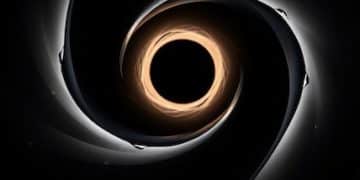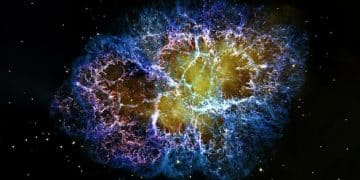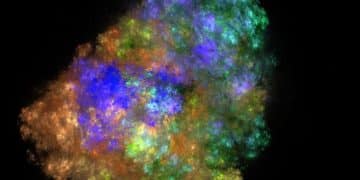Gamma-Ray Bursts: Unveiling the Universe’s Most Powerful Explosions
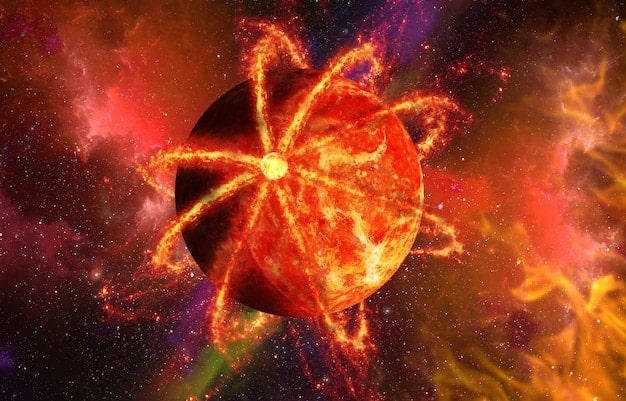
Gamma-ray bursts (GRBs) are the most luminous and energetic explosions in the universe, releasing colossal amounts of energy in the form of gamma rays, often associated with the collapse of massive stars or the merging of neutron stars at cosmological distances.
Have you ever wondered what the most powerful explosions in the universe are? We’re talking about events so energetic, they make supernovas look like firecrackers. These are gamma-ray bursts (GRBs), and understanding their origins is one of astronomy’s most exciting challenges. Let’s explore the fascinating world of these cosmic enigmas.
What are Gamma-Ray Bursts?
Gamma-ray bursts, or GRBs, are sudden flashes of gamma rays, the most energetic form of light, observed in distant galaxies. These bursts can last from milliseconds to several minutes, and during this brief period, they can outshine entire galaxies. But what exactly triggers these powerful explosions?
Initially discovered in the late 1960s by the Vela satellites, which were designed to detect nuclear weapons tests in space, GRBs quickly became a subject of intense scientific curiosity. Their unpredictable nature and immense distances made them difficult to study, but over the years, astronomers have pieced together a compelling picture of their origins.
The Discovery of Gamma-Ray Bursts
The accidental discovery by the Vela satellites marked the beginning of GRB research. Scientists initially puzzled over these events, unsure of their source or nature. The key was determining if these bursts originated from within our solar system, our galaxy, or from much farther away.
- Vela Satellites: These satellites, designed for nuclear test detection, unexpectedly recorded bursts of gamma rays, leading to the discovery of GRBs.
- Early Theories: Initial hypotheses ranged from local events in the solar system to exotic phenomena within the Milky Way.
- The Breakthrough: Determining the distances to GRBs, confirming their cosmological origin, was a major turning point.
The confirmation that GRBs originated from cosmological distances meant that they were vastly more energetic than almost any other known phenomenon in the universe. This discovery fueled further research into their causes and mechanisms.

Types of Gamma-Ray Bursts: Short and Long
One of the first major classifications of gamma-ray bursts came from noticing that some lasted longer than others. This distinction led to the categorization of GRBs into two primary types: short-duration bursts and long-duration bursts. These categories not only differ in duration but also in their likely origins.
Understanding the differences between short and long GRBs provides crucial insights into the different physical processes that can lead to these cataclysmic events. Each type represents a distinct pathway to creating these ultra-energetic explosions.
Long-Duration Gamma-Ray Bursts
Long-duration GRBs, lasting longer than two seconds, are typically associated with the death of massive stars. When these stars run out of fuel, their cores collapse, leading to a supernova and, under certain conditions, the formation of a black hole.
The formation of a black hole, coupled with the rapid rotation of the collapsing star, can generate powerful jets of particles that pierce through the star and erupt into space, producing the observed gamma rays.
Short-Duration Gamma-Ray Bursts
Short-duration GRBs, lasting less than two seconds, are believed to originate from the merging of two compact objects, such as neutron stars or a neutron star and a black hole. These mergers create a similar effect, launching narrowly focused jets of energy.
- Compact Object Mergers: These events involve neutron stars or black holes spiraling into each other and colliding.
- Gravitational Waves: The merger of compact objects also generates detectable gravitational waves, providing additional information.
- Rapid Processes: Short GRBs are characterized by extremely rapid energy release, making them particularly intense.
Observing both the gamma rays and the gravitational waves from these mergers offers a multi-messenger approach to understanding these events, providing complementary information about the physics involved.
The Collapsar Model: Death of a Massive Star
The collapsar model is the leading explanation for long-duration gamma-ray bursts. It describes the scenario in which a massive star, at the end of its life, collapses directly into a black hole, launching relativistic jets of material that produce the burst.
This model helps explain many of the observed properties of long GRBs, including their association with star-forming regions and their typical afterglows, which are the fading emissions at lower energies observed after the initial burst.
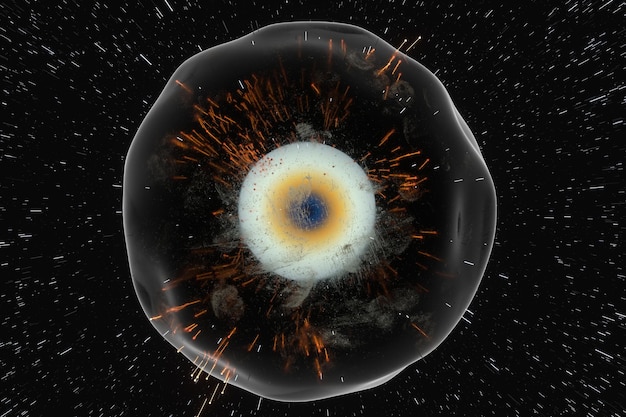
Conditions for a Collapsar
Not every massive star will produce a collapsar. Certain conditions must be met for this scenario to occur. These conditions involve the star’s mass, rotation rate, and magnetic field.
Stars that are very massive and rapidly rotating are more likely to form collapsars. The rapid rotation helps to create the accretion disk around the black hole, which is essential for launching the jets.
- High Mass: Collapsar-producing stars need to be significantly more massive than the Sun.
- Rapid Rotation: A high rotation rate is crucial for forming the accretion disk and launching jets.
- Low Metallicity: Lower concentrations of heavy elements in the star’s composition can promote collapsar formation.
The reason low metallicity is important is that stars with high metallicity tend to lose more mass during their lives, which can prevent them from forming a black hole directly. Stars with lower metallicity retain more of their mass and angular momentum, increasing the likelihood of forming a collapsar.
Neutron Star Mergers: A Different Path
While the collapsar model explains long-duration GRBs, short-duration GRBs are thought to arise from a completely different process: the merger of neutron stars or a neutron star and a black hole. These events are less common but equally dramatic.
The collision of these extremely dense objects releases an enormous amount of energy in a very short time, creating the characteristic short bursts of gamma rays. These mergers also produce significant gravitational waves, as confirmed by recent observations.
The Merger Process
The process leading up to a neutron star merger can take millions or even billions of years. Initially, two stars may be in a binary system. When both stars eventually become neutron stars, they gradually spiral in towards each other due to the emission of gravitational waves.
As the neutron stars get closer, their orbital period decreases, and the emission of gravitational waves increases, accelerating their collision. In the final moments, the neutron stars collide and merge, releasing a burst of gamma rays and a significant amount of heavy elements like gold and platinum.
- Binary Systems: Most neutron star mergers originate from binary star systems.
- Spiral In: Neutron stars gradually spiral towards each other, emitting gravitational waves.
- Kilonova: The aftermath of the merger includes a “kilonova,” a transient event brighter than a nova but dimmer than a supernova.
The kilonova is an important signature of neutron star mergers because it provides direct evidence of the production of heavy elements. The ejected material is rich in neutrons, which allows for the rapid neutron capture process (r-process) to occur, synthesizing heavy elements.
Observing Gamma-Ray Bursts: Challenges and Techniques
Observing gamma-ray bursts presents significant challenges due to their transient nature and unpredictable locations. Specialized telescopes and techniques are required to detect and study these events.
Despite these challenges, advancements in technology and observational strategies have greatly improved our ability to study GRBs. Multi-wavelength observations, combining gamma-ray data with observations at other wavelengths, provide a more complete picture of these energetic phenomena.
Gamma-Ray Telescopes
Gamma-ray telescopes, both space-based and ground-based, are essential for detecting GRBs. These telescopes are designed to detect the high-energy gamma rays emitted during the bursts.
Space-based telescopes, such as the Fermi Gamma-ray Space Telescope and the Neil Gehrels Swift Observatory, have the advantage of being above the Earth’s atmosphere, which absorbs most gamma rays. These telescopes can detect GRBs from any direction in the sky.
- Fermi: This telescope has a wide field of view and can detect a large number of GRBs.
- Swift: Swift can quickly repoint its telescopes to observe GRBs and their afterglows at different wavelengths.
- Ground-Based Telescopes: These telescopes use the Earth’s atmosphere as a detector, observing the Cherenkov radiation produced when gamma rays interact with the atmosphere.
Combining data from different telescopes allows astronomers to study GRBs in greater detail, revealing their properties and the environments in which they occur.
The Significance of Gamma-Ray Burst Research
The study of gamma-ray bursts is not just about understanding these spectacular explosions. It also provides insights into fundamental questions about the universe, such as the formation of black holes, the synthesis of heavy elements, and the evolution of galaxies.
GRBs serve as cosmic probes, allowing us to study the distant universe and test our understanding of physics under extreme conditions. Their immense luminosities make them visible across vast distances, enabling us to probe the early universe and learn about the conditions that existed shortly after the Big Bang.
Insights into the Early Universe
The light from distant GRBs can be used to study the intergalactic medium, the diffuse gas that fills the space between galaxies. By analyzing the absorption lines in the spectra of GRBs, astronomers can learn about the composition and distribution of this gas.
Studying GRBs at high redshifts (large distances) allows us to probe the era of the first stars and galaxies, providing clues about the early evolution of the universe. These observations help us understand how the first structures formed and how the universe evolved over cosmic time.
| Key Aspect | Brief Description |
|---|---|
| 💥 GRB Types | Short (mergers) and Long (collapsars), each with distinct origins. |
| 🌟 Collapsar Model | Massive star collapses into a black hole, launching powerful jets. |
| ⚗️ Element Synthesis | Mergers create heavy elements like gold and platinum. |
| 🔭 Observation | Utilizes space and ground telescopes to detect transient events. |
Frequently Asked Questions
▼
A gamma-ray burst is a highly energetic explosion observed in distant galaxies, characterized by a sudden flash of gamma rays. These are the most luminous events in the universe, briefly outshining entire galaxies.
▼
Short-duration gamma-ray bursts are believed to be caused by the merger of two compact objects, such as neutron stars or a neutron star and a black hole. These mergers release a burst of energy in a short time.
▼
The collapsar model describes the collapse of a massive star into a black hole, launching relativistic jets of material that produce the gamma-ray burst. The star must be very massive and rapidly rotating for this to occur.
▼
Telescopes, both space-based (like Fermi and Swift) and ground-based, are used to detect gamma-ray bursts. They observe the high-energy gamma rays emitted during the bursts, even through Earth’s atmosphere.
▼
GRBs provide insights into black hole formation, heavy element synthesis, and early universe conditions. Their brightness allows us to probe distant regions and test physics under extreme conditions, even at enormous distances.
Conclusion
Gamma-ray bursts continue to be a captivating area of astronomical research, offering valuable insights into some of the most energetic phenomena in the universe. From understanding the lifecycle of massive stars to probing the conditions of the early universe, these bursts serve as cosmic beacons, guiding us towards a deeper comprehension of the cosmos. As technology advances, our ability to observe and interpret these events will undoubtedly reveal even more about their origins and significance.


